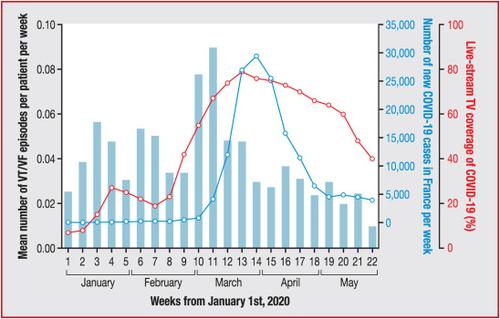Archives of Cardiovascular Diseases ( IF 2.3 ) Pub Date : 2021-05-24 , DOI: 10.1016/j.acvd.2021.02.005 Vincent Galand 1 , Elliot Hwang 2 , Estelle Gandjbakhch 3 , Frédéric Sebag 4 , Eloi Marijon 5 , Serge Boveda 6 , Christophe Leclercq 1 , Pascal Defaye 7 , Arnaud Rosier 8 , Raphaël Pedro Martins 1

|
Background
The coronavirus disease 2019 (COVID-19) has been a fast-growing worldwide pandemic.
Aims
We aimed to investigate the incidence of cardiac arrhythmias among a large French cohort of implantable cardioverter defibrillator recipients over the first 5 months of 2020.
Methods
Five thousand nine hundred and fifty-four implantable cardioverter defibrillator recipients were followed by remote monitoring during the COVID-19 period (from 01 January to 31 May 2020). Data were obtained from automated remote follow-up of implantable cardioverter defibrillators utilizing the Implicity® platform. For all patients, the type of arrhythmia (atrial fibrillation, ventricular tachycardia or ventricular fibrillation), the number of ventricular arrhythmia episodes and the type of implantable cardioverter defibrillator-delivered therapy were recorded.
Results
A total of 472 (7.9%) patients presented 4917 ventricular arrhythmia events. An increase in ventricular arrhythmia incidence was observed after the first COVID-19 case in France, and especially during weeks #10 and #11, at the time of major governmental measures, with an increase in the incidence of antitachycardia pacing delivered therapy. During the 11 weeks before the lockdown order, the curve of the percentage of live-stream television coverage of COVID-19 information matched the ventricular arrhythmia incidence. During the lockdown, the incidence of ventricular arrhythmia decreased significantly compared with baseline (0.05 ± 0.7 vs. 0.09 ± 1.2 episodes per patient per week, respectively; P < 0.001). Importantly, no correlation was observed between ventricular arrhythmia incidence and the curve of COVID-19 incidence. No changes were observed regarding atrial fibrillation/atrial tachycardia episodes over time.
Conclusions
An increase in ventricular arrhythmia incidence was observed in the 2 weeks before the lockdown order, at the time of major governmental measures. Ventricular arrhythmia incidence decreased dramatically during the lockdown.
中文翻译:

COVID-19 对植入式心律转复除颤器接受者心律失常发生率的影响,随后进行远程监测
背景
2019 年冠状病毒病 (COVID-19) 是一种快速增长的全球大流行病。
宗旨
我们的目的是调查 2020 年前 5 个月法国大量植入式心律转复除颤器接受者的心律失常发生率。
方法
在 COVID-19 期间(2020 年 1 月 1 日至 2020 年 5 月 31 日),对 5954 名植入式心律转复除颤器接受者进行了远程监测。数据来自使用 Implicity® 平台的植入式心律转复除颤器的自动远程随访。对于所有患者,记录了心律失常的类型(心房颤动、室性心动过速或心室颤动)、室性心律失常发作的次数和植入式心律转复除颤器提供的治疗类型。
结果
共有 472 名 (7.9%) 患者出现了 4917 次室性心律失常事件。在法国出现首例 COVID-19 病例后,观察到室性心律失常发生率增加,特别是在第 10 周和第 11 周期间,在政府采取重大措施时,抗心动过速起搏治疗的发生率增加。在封锁令前的 11 周内,COVID-19 信息的直播电视覆盖率曲线与室性心律失常发生率相匹配。在封锁期间,与基线相比,室性心律失常的发生率显着下降(每名患者每周分别为0.05 ± 0.7 次和 0.09 ± 1.2 次; P < 0.001)。重要的是,未观察到室性心律失常发生率与 COVID-19 发生率曲线之间存在相关性。随着时间的推移,没有观察到房颤/房性心动过速发作的变化。
结论
在封锁令前 2 周,即政府采取重大措施时,观察到室性心律失常发生率有所增加。在锁定期间,室性心律失常的发生率急剧下降。











































 京公网安备 11010802027423号
京公网安备 11010802027423号